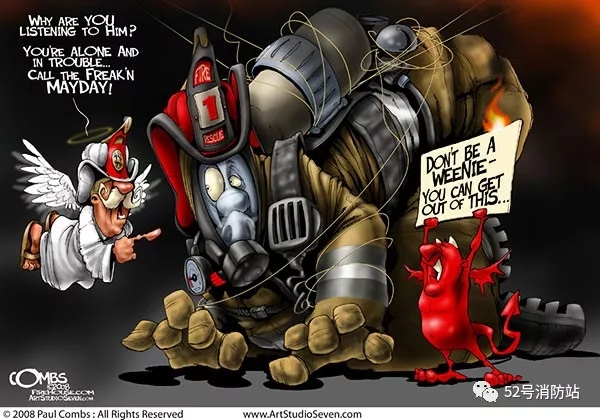
左边天使老爷爷:
Why are you listening to him? Youre alone and in trouble, call the freakn MAYDAY!
别听它的!你有大麻烦了,赶紧叫五月天救命!
右边小恶魔:
Dont be a weenie. You can get out of this...
别跟个没胆鬼似的,你能搞定的。。。
双语版:
Chap 1
第一章
Introduction
序言
OBJECTIVES
目标
At the conclusion of this chapter, you will be able to:
在本章结束时,您将能够:
• Understand the importance of studying building construction as a fire fighter.
懂得作为一位消防员学习建筑施工的重要性。
• Understand why using proper language is so important for comprehending building construction techniques and for fireground safety.
懂得使用恰当的词语对于理解建筑施工技术和火场行动安全的重要性。
• Understand why evacuation protocols are critical.
懂得撤退计划的重要性。
• Identify the role of prefire plans and prefire analysis in firefighting operations.
理解预案如何在灭火行动中发挥作用。
• Understand the importance of looking for building deficiencies and dangerous conditions while conducting prefire planning walkthroughs.
懂得在预案预演过程中寻找建筑缺陷和危险情况的重要性
• Explain why it is so important to study reports of significant fires, NIOSH Fire Fighter Fatality and Near Miss reports of the past.
阐明学习重大火灾报告,NIOSH消防员殉职调查报告和未遂事件报告的重要性。
• Understand the relationship between risk and benefit and its impact on fire fighter safety.
懂得风险和收益的关系和其对消防员安全的影响。
Case Study
典型案例
On December 3, 1999, a fire broke out in an abandoned cold storage warehouse in Worcester, Massachusetts (Figure 1-1).
1999年12月3日,马萨诸塞州伍斯特市一间废弃的冷库发生火灾(图1-1)。
The large seven-story structure—actually two connected buildingswas built in the years preceding World War I.
这栋大型建筑由两栋建于一战前的建筑连接而成。
Since the structure had been used to process meat and store frozen foods, its interior surfaces were lined with asphalt-impregnated cork, supplemented in later years with polystyrene foam.
主要用于加工和冷冻储存肉类,建筑内表面全部覆盖了浸过沥青的软木板,后期部分软木板又被聚苯乙烯泡沫板替换。
In addition, the structure was essentially windowless, given the need to keep the interior cold. There was only a single exit from the upper floors.
此外,整个建筑为了保温没有一扇窗,只有一个出入口通往上部楼层。
图 1-1 伍斯特市冷库火灾
Arriving fire fighters began searching for the fire and people in the maze-like structure.
消防员到场后开始在这栋迷宫一样的建筑内搜索被困人员和火点。
The building was a known domicile for squatters; rumors of homeless people being trapped in the building surfaced during the early stages of the fire.
这栋建筑是众所周知的流民居所,在火灾初期有传言说流浪汉被困在火场里。
As fire fighters operated in the building, conditions deteriorated rapidly.
消防员在建筑内展开行动不久,情况迅速恶化。
Two fire fighters became lost and began running low on air.
两名消防员失联且空呼告警。
They called for help, and succeeding sets of fire fighters began a frantic search for them.
他们呼叫了救援,后续消防员尽全力展开搜救行动。
With conditions getting even worse, four additional fire fighters became lost in the building.
随着情况进一步恶化,又有4名消防员失联。
The district chief in charge of interior operations made the decision to not allow any more fire fighters into the building.
负责内攻任务的战区长最后决定所有消防员撤离建筑。
He physically put himself in the stairway, preventing fire fighters from going up the stairs. The six missing fire fighters lost their lives.
他站在楼梯口,阻止任何想要进去的消防员。最终,这6名失联的消防员殉职。
How difficult was it for the district chief to decide to not allow any additional fire fighters into the building to search for their lost brother fire fighters?
不允许消防员进入火场搜救他们的战友,做出这样的决定并非易事。
To Be Continued
未完待续
题外话:
https://wwwn.cdc.gov/NIOSH-fire-fighter-face/Default.cshtml?state=ALL&Incident_Year=ALL&Submit=Submit
这个链接是NIOSH(国家职业安全与健康研究所)1985年以来出具的所有消防员殉职报告,共661个,有兴趣的读者可以看看人家的报告是怎么写的。
NIOSH的上级主管部门是CDC(疾病预防与控制中心),前两年伊波拉病毒肆虐的时候,CDC没少出来刷存在感,消防员火场殉职也是他们的管辖范围,八竿子打不着的部门,这逻辑是不是很有意思?
往期文章: